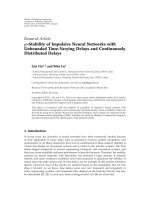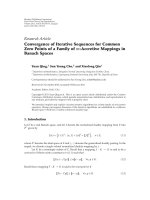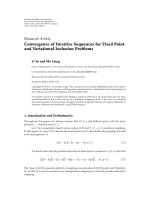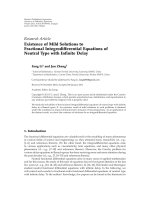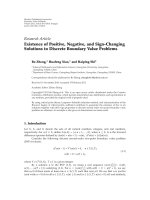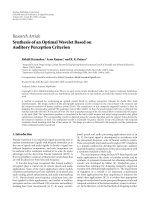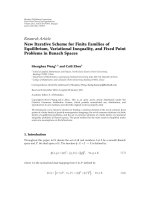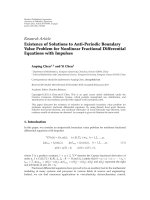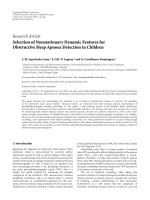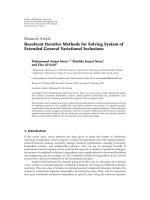báo cáo hóa học:" Research Article Approximation of Solutions for Second-Order m-Point Nonlocal Boundary Value Problems via the Method of Generalized Quasilinearization" pdf
Bạn đang xem bản rút gọn của tài liệu. Xem và tải ngay bản đầy đủ của tài liệu tại đây (544.2 KB, 17 trang )
Hindawi Publishing Corporation
Boundary Value Problems
Volume 2011, Article ID 929061, 17 pages
doi:10.1155/2011/929061
Research Article
Approximation of Solutions for Second-Order
m-Point Nonlocal Boundary Value Problems via
the Method of Generalized Quasilinearization
Ahmed Alsaedi
Department of Mathematics, Faculty of Science, King Abdulaziz University, P.O. Box 80203,
Jeddah 21589, Saudi Arabia
Correspondence should be addressed to Ahmed Alsaedi,
Received 11 May 2010; Revised 29 July 2010; Accepted 2 October 2010
Academic Editor: Gennaro Infante
Copyright q 2011 Ahmed Alsaedi. This is an open access article distributed under the Creative
Commons Attribution License, which permits unrestricted use, distribution, and reproduction in
any medium, provided the original work is properly cited.
We discuss the existence and uniqueness of the solutions of a second-order m-point nonlocal
boundary value problem by applying a generalized quasilinearization technique. A monotone
sequence of solutions converging uniformly and quadratically to a unique solution of the problem
is presented.
1. Introduction
The monotone iterative technique coupled with the method of upper and lower solutions
1–7 manifests itself as an effective and flexible mechanism that offers theoretical as well as
constructive existence results in a closed set, generated by the lower and upper solutions. In
general, the convergence of the sequence of approximate solutions given by the monotone
iterative technique is at most linear 8, 9. To obtain a sequence of approximate solutions
converging quadratically, we use the method of quasilinearization 10. This method has been
developed for a variety of problems 11–20. In view of its diverse applications, this approach
is quite an elegant and easier for application algorithms.
The subject of multipoint nonlocal boundary conditions, initiated by Bicadze and
Samarski
˘
ı21, has been addressed by many authors, for instance, 22–32. The multipoint
boundary conditions appear in certain problems of thermodynamics, elasticity and wave
propagation, see 23 and the references therein. The multipoint boundary conditions may
be understood in the sense that the controllers at the endpoints dissipate or add energy
according to censors located at intermediate positions.
2 Boundary Value Problems
In this paper, we develop the method of generalized quasilinearization to obtain a
sequence of approximate solutions converging monotonically and quadratically to a unique
solution of the following second-order m−point nonlocal boundary value problem
−x
t
f
t, x
t
,x
t
,t∈
0, 1
, 1.1
px
0
− qx
0
m−2
i1
τ
i
x
η
i
,px
1
qx
1
m−2
i1
σ
i
x
η
i
,η
i
∈
0, 1
,
1.2
where f : 0, 1 × R × R → R is continuous and τ
i
,σ
i
i 1, 2, ,m− 2 are nonnegative real
constants such that
m−2
i1
τ
i
< 1,
m−2
i1
σ
i
< 1, and p, q > 0withp>1.
Here we remark that 26 studies 1.1 with the boundary conditions of the form
δx
0
− γx
0
0,x
1
m−2
i1
α
i
x
η
i
,η
i
∈
0, 1
.
1.3
A perturbed integral equation equivalent to the problem 1.1 and 1.3 considered in 26 is
x
t
1
0
k
t, s
f
s, x
s
,x
s
ds
m−2
i1
α
i
x
η
i
t
2
,
1.4
where
k
t, s
1
δ γ
⎧
⎨
⎩
γ δt
1 − s
, 0 ≤ t ≤ s,
δ γs
1 − t
,s≤ t ≤ 1.
1.5
It can readily be verified that the solution given by 1.4 does not satisfy 1.1. On the other
hand, by Green’s function method, a unique solution of the problem 1.1 and 1.3 is
x
t
1
0
k
t, s
f
s, x
s
,x
s
ds
m−2
i1
α
i
x
η
i
γ δt
δ γ
,
1.6
where kt, s is given by 1.5.Thus,1.6 represents the correct form of the solution for the
problem 1.1 and 1.3.
Boundary Value Problems 3
2. Preliminaries
For x ∈ C
1
0, 1, we define x
1
x x
, where x max{|xt| : t ∈ 0, 1}. It can easily
be verified that the homogeneous problem associated with 1.1-1.2 has only the trivial
solution. Therefore, by Green’s function method, the solution of 1.1-1.2 can be written as
x
t
1
0
G
t, s
f
s, x
s
,x
s
ds
m−2
i1
τ
i
x
η
i
−t
2q p
q p
p
2q p
m−2
i1
σ
i
x
η
i
t
2q p
q
p
2q p
,
2.1
where Gt, s is the Green’s function and is given by
G
t, s
1
p
p 2q
⎧
⎨
⎩
q pt
q p
1 − s
, 0 ≤ t ≤ s,
q ps
q p
1 − t
, s ≤ t ≤ 1.
2.2
Note that Gt, s > 0on0, 1 × 0, 1.
We say that α ∈ C
2
0, 1 is a lower solution of the boundary value problem 1.1 and
1.2 if
−α
t
≤ f
t, α
t
,α
t
,t∈
0, 1
,
pα
0
− qα
0
≤
m−2
i1
τ
i
α
η
i
,pα
1
qα
1
≤
m−2
i1
σ
i
α
η
i
,
2.3
and β ∈ C
2
0, 1 is an upper solution of 1.1 and 1.2 if
−β
t
≥ f
t, β
t
,β
t
,t∈
0, 1
,
pβ
0
− qβ
0
≥
m−2
i1
τ
i
β
η
i
,pβ
1
qβ
1
≥
m−2
i1
σ
i
β
η
i
.
2.4
Definition 2.1. A continuous function h : 0, ∞ → 0, ∞ is called a Nagumo function if
∞
λ
sds
h
s
∞,
2.5
for λ ≥ 0. We say that f ∈ C0, 1 × R × R satisfies a Nagumo condition on 0, 1 relative
to α, β if for every t ∈ 0, 1 and x ∈ min
t∈0,1
αt, max
t∈0,1
βt, there exists a Nagumo
function h such that |ft, x, x
|≤h|x
|.
We need the following result 33 to establish the main result.
4 Boundary Value Problems
Theorem 2.2. Let f : 0, 1 × R
2
→ R be a continuous function satisfying the Nagumo condition
on E {t, x, y ∈ 0, 1 × R
2
: α ≤ x ≤ β} where α, β : 0, 1 → R are continuous functions such
that αt ≤ βt for all t ∈ 0, 1. Then there exists a constant M>0 (depending only on α, β, the
Nagumo function h) such that every solution x of 1.1-1.2 with αt ≤ xt ≤ βt, t ∈ 0, 1
satisfies |x
|≤M.
If α, β ∈ C
2
0, 1 are assumed to be lower and upper solutions of 1.1-1.2,
respectively, in the statement of Theorem 2.2, then there exists a solution, xt of 1.1 and
1.2 such that αt ≤ xt ≤ βt, t ∈ 0, 1.
Theorem 2.3. Assume that α, β ∈ C
2
0, 1 are, respectively, lower and upper solutions of 1.1-1.2.
If ft, x, y ∈ C0, 1 × R × R is decreasing in x for each t, y ∈ 0, 1 × R, then α ≤ β on 0, 1.
Proof. Let us define utαt − βt so that u ∈ C
2
0, 1 and satisfies the boundary
conditions
pu
0
− qu
0
≤
m−2
i1
τ
i
u
η
i
,pu
1
qu
1
≤
m−2
i1
σ
i
u
η
i
.
2.6
For the sake of contradiction, let u have a positive maximum at some t
0
∈ 0, 1.Ift
0
∈ 0, 1,
then u
t
0
0andu
t
0
≤ 0. On the other hand, in view of the decreasing property of
ft, x, y in x, we have
u
t
0
α
t
0
− β
t
0
≥−f
t
0
,α
t
0
,α
t
0
f
t
0
,β
t
0
,β
t
0
> 0, 2.7
which is a contradiction. If we suppose that u has a positive maximum at t
0
0, then it
follows from the first of boundary conditions 2.6 that
pu
0
− qu
0
≤
m−2
i1
τ
i
u
η
i
≤ u
0
,
2.8
which implies that p − 1u0 ≤ qu
0. Now as p>1, q>0, u0 > 0, u
0 ≤ 0, therefore
we obtain a contradiction. We have a similar contradiction at t
0
1. Thus, we conclude that
αt ≤ βt, t ∈ 0, 1.
3. Main Results
Theorem 3.1. Assume that
A
1
the functions α, β ∈ C
2
0, 1 are, respectively, lower and upper solutions of 1.1-1.2
such that α ≤ β on 0, 1;
A
2
the function f ∈ C
2
0, 1 × R × R satisfies a Nagumo condition relative to α, β
and f
x
≤ 0 on 0, 1 × min
t∈0,1
αt, max
t∈0,1
βt × −M, M, where M is a
positive constant depending on α, β, and the Nagumo function h. Further, there exists
a function φ ∈ C
2
0, 1 × R
2
such that Ψf φ ≥ 0 with Ψφ ≥ 0 on 0, 1 ×
min
t∈0,1
αt, max
t∈0,1
βt × −M, M, where
Ψ
x − y
2
∂
2
∂x
2
2
x − y
x
− y
∂
2
∂x∂x
x
− y
2
∂
2
∂x
2
.
3.1
Boundary Value Problems 5
Then, there exists a monotone sequence {α
n
} of approximate solutions converging uniformly to a
unique solution of the problems 1.1-1.2.
Proof. For y ∈ R, we define ωymax{−M, min{y, M}} and consider the following
modified m-point BVP
−x
t
f
t, x
t
,ω
x
t
,t∈
0, 1
,
px
0
− qx
0
m−2
i1
τ
i
x
η
i
,px
1
qx
1
m−2
i1
σ
i
x
η
i
.
3.2
We note that α, β are, respectively, lower and upper solutions of 3.2 and for every t, x ∈
0, 1 × min
t∈0,1
αt, max
t∈0,1
βt, we have
f
≤ h
ω
x
h
x
,
3.3
where
h·hω·. As
∞
0
sds
h
s
M
0
sds
h
s
∞
M
sds
h
M
∞,
3.4
so
h is a Nagumo function. Furthermore, there exists a constant N depending on α, β,and
Nagumo function h such that
M
0
sds
h
s
≥
N
0
sds
h
s
>
max
β
t
: t ∈
0, 1
− min
{
α
t
: t ∈
0, 1
}
,
3.5
where M>max{N, α
, β
}. Thus, any solution x of 3.2 with αt ≤ xt ≤ βt, t ∈ 0, 1
satisfies |x
|≤M on 0, 1 and hence it is a solution of 1.1-1.2.
Let us define a f unction F : 0, 1 × R
2
→ R by
F
t, x, x
f
t, x, x
φ
t, x, x
− ω
x
. 3.6
In view of the assumption A
2
, it follows that F ∈ C
2
0, 1 × R
2
and satisfies ΨF ≥ 0on
0, 1 × min
t∈0,1
αt, max
t∈0,1
βt × −M, M. Therefore, by Taylor’s theorem, we obtain
f
t, x, ω
x
≥ f
t, y, ω
y
F
x
t, y, ω
y
x − y
F
x
t, y, ω
y
ω
x
− ω
y
−
φ
t, x, 0
− φ
t, y, 0
≥ f
t, y, ω
y
F
x
t, y, ω
y
− φ
x
t, β, 0
x − y
F
x
t, y, ω
y
ω
x
− ω
y
.
3.7
6 Boundary Value Problems
We set
H
t, x, x
; y,y
f
t, y, ω
y
F
x
t, y, ω
y
− φ
x
t, β, 0
x − y
F
x
t, y, ω
y
ω
x
− ω
y
,
3.8
and observe that
f
t, x, ω
x
≥ H
t, x, x
; y,y
,
f
t, x, ω
x
H
t, x, x
; x, x
.
3.9
By the mean value theorem, we can find α ≤ c
1
≤ y and α
≤ c
2
≤ y
c
1
,c
2
depend on y,y
,
resp., such that
f
t, y, ω
y
− f
t, α
t
,α
t
f
x
t, c
1
,c
2
y − α
t
f
x
t, c
1
,c
2
ω
y
− α
t
. 3.10
Letting
H
1
t, x, x
; y,y
f
t, α
t
,α
t
f
x
t, c
1
,c
2
x − α
t
f
x
t, c
1
,c
2
ω
x
− α
t
,
3.11
we note that
f
t, y, ω
y
H
1
t, y, y
; y,y
,
f
t, α
t
,α
t
H
1
t, α
t
,α
t
; y,y
.
3.12
Let us define
H as
H
⎧
⎨
⎩
H
t, x, x
; y,y
, for x ≥ y,
H
1
t, x, x
; y,y
, for x ≤ y.
3.13
Clearly
H is continuous and bounded on 0, 1×min
t∈0,1
αt, max
t∈0,1
βt×R and satisfies
a Nagumo condition relative to α, β. For every αt ≤ y ≤ βt and y
∈ R, we consider the
m-point BVP
−x
H
t, x, x
; y,y
,t∈
0, 1
,
px
0
− qx
0
m−2
i1
τ
i
x
η
i
,px
1
qx
1
m−2
i1
σ
i
x
η
i
.
3.14
Boundary Value Problems 7
Using 3.9, 3.12 and 3.13, we have
H
t, α
t
,α
t
; y,y
H
1
t, α
t
,α
t
; y,y
f
t, α
t
,α
t
≥−α
t
,
pα
0
− qα
0
≤
m−2
i1
τ
i
α
η
i
,pα
1
qα
1
≤
m−2
i1
σ
i
α
η
i
,
H
t, β
t
,β
t
; y,y
H
t, β
t
,β
t
; y,y
≤ f
t, β
t
,β
t
≤−β
t
,
pβ
0
− qβ
0
≥
m−2
i1
τ
i
β
η
i
,pβ
1
qβ
1
≥
m−2
i1
σ
i
β
η
i
.
3.15
Thus, α, β are lower and upper solutions of 3.14, respectively. Since
H satisfies a Nagumo
condition, there exists a constant M
1
> max{α
, β
} depending on α, β and a Nagumo
function such that any solution x of 3.14 with αt ≤ xt ≤ βt satisfies |x
| <M
1
on 0, 1.
Now, we choose α
0
α and consider the problem
−x
H
t, x, x
; α
0
,α
0
,t∈
0, 1
,
px
0
− qx
0
m−2
i1
τ
i
x
η
i
,px
1
qx
1
m−2
i1
σ
i
x
η
i
.
3.16
Using A
1
, 3.9, 3.12 and 3.13,weobtain
H
t, α
0
,α
0
; α
0
,α
0
f
t, α
0
,α
0
≥−α
0
t
,
pα
0
0
− qα
0
0
≤
m−2
i1
τ
i
α
0
η
i
,pα
0
1
qα
0
1
≤
m−2
i1
σ
i
α
0
η
i
,
H
t, β
t
,β
t
; α
0
,α
0
H
t, β
t
,β
t
; α
0
,α
0
≤ f
t, β
t
,β
t
≤−β
t
,
pβ
0
− qβ
0
≥
m−2
i1
τ
i
β
η
i
,pβ
1
qβ
1
≥
m−2
i1
σ
i
β
η
i
,
3.17
which imply that α
0
and β are lower and upper solutions of 3.16. Hence by Theorems 2.2
and 2.3, there exists a unique solution α
1
of 3.16 such that
α
0
≤ α
1
≤ β
t
,
α
1
≤ M
1
,t∈
0, 1
. 3.18
8 Boundary Value Problems
Note that the uniqueness of the solution follows by Theorem 2.3.Using3.9 and 3.13
together with the fact that α
1
is solution of 3.16,wefindthatα
1
is a lower solution of 3.2,
that is,
−α
1
H
t, α
1
,α
1
; α
0
,α
0
≤ f
t, α
1
,ω
α
1
,t∈
0, 1
,
pα
1
0
− qα
1
0
m−2
i1
τ
i
α
1
η
i
,pα
1
1
qα
1
1
m−2
i1
σ
i
α
1
η
i
.
3.19
In a similar manner, it can be shown by using A
1
, 3.12, 3.13,and3.19 that α
1
and β are
lower and upper solutions of the following m-point BVP
−x
H
t, x, x
; α
1
,α
1
,t∈
0, 1
,
px
0
− qx
0
m−2
i1
τ
i
x
η
i
,px
1
qx
1
m−2
i1
σ
i
x
η
i
.
3.20
Again, by Theorems 2.2 and 2.3, there exists a unique solution α
2
of 3.20 such that
α
1
t
≤ α
2
t
≤ β
t
,
α
2
t
≤ M
1
,t∈
0, 1
. 3.21
Continuing this process successively, we obtain a bounded monotone sequence {α
n
} of
solutions satisfying
α
1
t
≤ α
2
t
≤ α
3
t
≤···≤α
n
t
≤ β
t
,t∈
0, 1
, 3.22
where α
n
is a solution of the problem
−x
H
t, x, x
; α
n−1
,α
n−1
,t∈
0, 1
,
px
0
− qx
0
m−2
i1
τ
i
x
η
i
,px
1
qx
1
m−2
i1
σ
i
x
η
i
,
3.23
and is given by
x
t
1
0
G
t, s
H
s, α
n
,α
n
; α
n−1
,α
n−1
ds
m−2
i1
τ
i
x
η
i
−t
2q p
q p
p
2q p
m−2
i1
σ
i
x
η
i
t
2q p
q
p
2q p
.
3.24
Since
H is bounded on 0, 1 × min
t∈0,1
αt, max
t∈0,1
βt × R × min
t∈0,1
αt,
max
t∈0,1
βt × R, therefore it follows that the sequences {α
j
n
}j 0, 1 are uniformly
bounded and equicontinuous on 0, 1. Hence, by Ascoli-Arzela theorem, there exist the
subsequences and a function x ∈ C
1
0, 1 such that α
j
n
→ x
j
uniformly on 0, 1 as
Boundary Value Problems 9
n →∞. Taking the limit n →∞, we find that
Ht, α
n
,α
n
; α
n−1
,α
n−1
→ ft, x, ωx
which
consequently yields
x
t
1
0
G
t, s
f
s, x
s
,ω
x
s
ds
m−2
i1
τ
i
x
η
i
−t
2q p
q p
p
2q p
m−2
i1
σ
i
x
η
i
t
2q p
q
p
2q p
.
3.25
This proves that x is a solution of 3.2.
Theorem 3.2. Assume that A
1
and A
2
hold. Further, one assumes that
A
3
the function F ∈ C
2
0, 1 × R × R satisfies y∂/∂x
Ft, x, ymy
2
≤ 0 for |y|≥
M, where m max{|F
x
x
t, x, y| : t, x, y ∈ 0, 1 × min
t∈0,1
αt, max
t∈0,1
βt ×
−M, M}, and F f φ.
Then, the convergence of the sequence {α
n
} of approximate solutions (obtained in Theorem 3.1)is
quadratic.
Proof. Let us set e
n1
txt − α
n1
t ≥ 0sothate
n1
satisfies the boundary conditions
pe
n1
0
− qe
n1
0
m−2
i1
τ
i
e
n1
η
i
,pe
n1
1
qe
n1
1
m−2
i1
σ
i
e
n1
η
i
.
3.26
In view of the assumption A
3
, for every t, x ∈ 0, 1 × min
t∈0,1
αt, max
t∈0,1
βt, it
follows that
F
x
t, x, M
2mM ≤ 0,F
x
t, x, −M
− 2mM ≥ 0. 3.27
Now, by Taylor’s theorem, we have
−e
n1
t
F
t, x, x
− φ
t, x, 0
−
f
t, α
n
,ω
α
n
F
x
t, α, ω
α
n
α
n1
− α
n
− φ
x
t, β, 0
α
n1
− α
n
F
x
t, α
n
,ω
α
n
ω
α
n1
− ω
α
n
F
x
t, α
n
,ω
α
n
x − α
n1
F
x
t, α
n
,ω
α
n
x
− ω
α
n1
1
2
x − α
n
2
F
xx
t, z
1
,z
2
2
x − α
n
x
− ω
α
n
F
xx
t, z
1
,z
2
x
− ω
α
n
2
F
x
x
t, z
1
,z
2
−
φ
t, x, 0
− φ
t, α
n
, 0
− φ
x
t, β, 0
α
n1
− α
n
≤ F
x
t, α
n
,ω
α
n
x
− ω
α
n1
M
2
2
|
x − α
n
|
x
− ω
α
n
2
ρ
1
x − α
n
2
,
3.28
10 Boundary Value Problems
where α
n
≤ z
1
≤ x, ωα
n
≤ z
2
≤ x
, α
n
≤ ξ ≤ β, M
2
max{|F
xx
|, |F
xx
|, |F
x
x
|} on
0, 1 × min
t∈0,1
αt, max
t∈0,1
βt × −M, M and ρ
1
ρ max{φ
xx
t, x, 0 : t, x, 0 ∈
0, 1 × min
t∈0,1
αt, max
t∈0,1
βt} with ρ>1 satisfying β − α
n
≤ ρx − α
n
on 0, 1. Also,
in view of 3.13, we have
−e
n1
t
f
t, x, x
−
H
t, α
n1
,α
n1
; α
n
,α
n
≥ f
t, x, x
− f
t, α
n1
,ω
α
n1
f
x
t, c
3
,c
4
e
n1
f
x
t, c
3
,c
4
x
− ω
α
n1
≥−γe
n1
f
x
t, c
3
,c
4
x
− ω
α
n1
,
3.29
where α
n1
≤ c
3
≤ x, ωα
n1
≤ c
4
≤ x
and γ max{|f
x
t, x, y| : t, x, y ∈ 0, 1 ×
min
t∈0,1
αt, max
t∈0,1
βt × −M, M}.
Nowweshowthatωα
n1
t α
n1
t. By the mean value theorem, for every y
1
∈
−M, M and ωα
n1
t ≤ c
5
≤ y
1
, we obtain
F
x
t, α
n
t
,y
1
F
x
t, α
n
t
,ω
α
n1
t
F
x
x
t, α
n
t
,c
5
y
1
− ω
α
n1
t
. 3.30
Let α
n1
>Mfor some t ∈ 0, 1. Then ωα
n1
t M and 3.30 becomes
F
x
t, α
n
t
,y
1
F
x
t, α
n
t
,M
F
x
x
t, α
n
t
,c
5
y
1
− M
≤ F
x
t, α
n
t
,M
− m
y
1
− M
.
3.31
In particular, taking y
1
−M and using 3.27, we have
F
x
t, α
n
t
, −M
≤ F
x
t, α
n
t
,M
2mM ≤ 0, 3.32
which contradicts that F
x
t, α
n
t, −M ≥ 2mM > 0. Similarly, letting α
n1
< −M for some
t ∈ 0, 1, we get a contradiction. Thus, it follows that |α
n1
t|≤M for every t ∈ 0, 1, which
implies that ωα
n1
t α
n1
t and consequently, 3.28 and 3.29 take the form
−e
n1
t
≤ F
x
t, α
n
,ω
α
n
t
e
n1
t
M
3
e
n
2
1
,
3.33
where M
3
ρ
1
M
2
/2 and
−e
n1
t
≥−γe
n1
t
f
x
t, c
3
,c
4
e
n1
t
. 3.34
Now, by a comparison principle, we can obtain e
n1
t ≤ rt on 0, 1, where rt is a solution
of the problem
−r
t
F
x
t, α
n
,ω
α
n
t
r
t
M
3
e
n
2
1
,
pr
0
− qr
0
m−2
i1
τ
i
e
n1
η
i
,pr
1
qr
1
m−2
i1
σ
i
e
n1
η
i
.
3.35
Boundary Value Problems 11
Since F
x
is continuous and bounded on 0, 1 × min
t∈0,1
αt, max
t∈0,1
βt × R, there exist
ζ
2
,ζ
1
> 0 independent of n such that −ζ
1
≤ F
x
≤ ζ
2
on 0, 1 × min
t∈0,1
αt, max
t∈0,1
βt ×
−M, M. Since ζ
2
− F
x
t, α
n
,ωα
n
≥ 0on0, 1, so we can rewrite 3.35 as
r
t
ζ
2
r
t
ζ
2
− F
x
t, α
n
,ω
α
n
r
t
− M
3
e
n
2
1
pr
0
− qr
0
m−2
i1
τ
i
e
n1
η
i
,pr
1
qr
1
m−2
i1
σ
i
e
n1
η
i
,
3.36
whose solution is given by
r
t
1
0
G
ζ
2
t, s
ζ
2
− F
x
t, α
n
,ω
α
n
r
s
− M
3
e
n
2
1
ds
m−2
i1
τ
i
e
n1
η
i
−t
2q p
q p
p
2q p
m−2
i1
σ
i
e
n1
η
i
t
2q p
q
p
2q p
3.37
where
G
ζ
2
t, s
−1
ζ
2
p qζ
2
/p − e
−ζ
2
⎧
⎪
⎪
⎪
⎪
⎨
⎪
⎪
⎪
⎪
⎩
1 −
p ζ
2
q
p
e
−ζ
2
1−s
p ζ
2
q
p
− e
−ζ
2
t
, 0 ≤ t ≤ s,
e
−ζ
2
t−s
−
p ζ
2
q
p
e
−ζ
2
1−s
p ζ
2
q
p
− e
−ζ
2
s
, s ≤ t ≤ 1,
3.38
Introducing the integrating factor μte
t
0
F
x
s,α
n
s,ωα
n
sds
such that e
−ζ
1
t
<μ≤ e
ζ
2
t
, 3.34
takes the form
r
t
μ
t
−M
3
e
n
2
1
μ
t
.
3.39
Integrating 3.39 from 0 to t and using r
0 ≥ −1/q
m−2
i1
τ
i
e
n1
η
i
, we obtain
r
t
μ
t
≥
−1
q
m−2
i1
τ
i
e
n1
η
i
− M
3
e
n
2
1
t
0
μ
s
ds,
3.40
which can alternatively be written as
r
t
≥
−1
qe
ζ
1
t
m−2
i1
τ
i
e
n1
η
i
−
M
3
ζ
2
e
ζ
1
t
e
n
2
1
e
ζ
2
− 1
≥
−1
q
m−2
i1
τ
i
e
n1
−
M
3
ζ
2
e
n
2
1
e
ζ
2
− 1
−ρ
1
e
n1
− ρ
2
e
n
2
1
,
3.41
12 Boundary Value Problems
where ρ
1
1/q
m−2
i1
τ
i
, ρ
2
M
3
/ζ
2
e
ζ
2
− 1. Using the fact that G
ζ
2
t, s ≤ 0 together with
3.41 yields
G
ζ
2
t, s
ζ
2
− F
x
r
t
≤
G
ζ
2
t, s
ζ
2
− F
x
ρ
1
e
n1
ρ
2
e
n
2
1
≤
G
ζ
2
t, s
ζ
2
ζ
1
ρ
1
e
n1
ρ
2
e
n
2
1
,
3.42
which, on substituting in 3.37, yields
e
n1
≤ r
t
≤
1
0
G
ζ
2
t, s
ζ
2
ζ
1
ρ
1
e
n1
ρ
2
e
n
2
1
M
3
e
n
2
1
ds
m−2
i1
τ
i
e
n1
η
i
−t
2q p
q p
p
2q p
m−2
i1
σ
i
e
n1
η
i
t
2q p
q
p
2q p
≤
1
0
G
ζ
2
t, s
ζ
2
ζ
1
ρ
1
e
n1
ds
1
0
G
ζ
2
t, s
ρ
2
ζ
2
ζ
1
M
3
e
n
2
1
ds
m−2
i1
τ
i
m−2
i1
σ
i
p q
p
2q p
e
n1
η
i
≤
B
m−2
i1
τ
i
m−2
i1
σ
i
p q
p
2q p
e
n1
A
e
n
2
1
,
3.43
where
A
ρ
2
ζ
2
ζ
1
M
3
max
1
0
G
ζ
2
t, s
ds, B
ζ
2
ζ
1
ρ
1
max
1
0
G
ζ
2
t, s
ds.
3.44
Taking the maximum over 0, 1 and then solving 3.43 for e
n1
, we obtain
e
n1
≤
A
1 − B −
m−2
i1
τ
i
m−2
i1
σ
i
p q/p
2q p
e
n
2
1
.
3.45
Also, it follows from 3.33 that
e
n1
μ
t
≥−M
3
e
n
2
1
μ
t
≥−M
3
e
ζ
2
t
e
n
2
1
,t∈
0, 1
.
3.46
Integrating 3.46 from0tot and using v
n1
0 ≥ −1/q
m−2
i1
τ
i
e
n1
η
i
from the boundary
condition pe
n1
0 − qe
n1
0
m−2
i1
τ
i
e
n1
η
i
, we obtain
e
n1
t
μ
t
≥
−1
q
m−2
i1
τ
i
e
n1
η
i
−
M
3
e
ζ
2
t
− 1
ζ
2
e
n
2
1
,
3.47
Boundary Value Problems 13
which, in view of the fact e
−ζ
1
t
<μ≤ e
ζ
2
t
and 3.45, yields
e
n1
t
≥ e
ζ
1
t
⎡
⎢
⎣
−1
q
m−2
i1
τ
i
⎛
⎜
⎝
A
1 − B −
m−2
i1
τ
i
m−2
i1
σ
i
p q
/p
2q p
⎞
⎟
⎠
−
M
3
e
ζ
2
t
− 1
ζ
2
e
n
2
1
≥−δ
1
e
n
2
1
,
3.48
where
δ
1
max
⎧
⎪
⎨
⎪
⎩
e
ζ
1
t
⎡
⎢
⎣
1
q
m−2
i1
τ
i
⎛
⎜
⎝
A
1 − B −
m−2
i1
τ
i
m−2
i1
σ
i
p q
/p
2q p
⎞
⎟
⎠
M
3
e
ζ
2
t
− 1
ζ
2
,t∈
0, 1
.
3.49
As e
n1
∈ C
1
0, 1, there exists t ∈ 0, 1 such that
e
n1
t
e
n1
1
− e
n1
0
≤ e
n1
1
≤
1
p
m−2
i1
σ
i
e
n1
η
i
−
q
p
e
n1
1
≤
1
p
m−2
i1
σ
i
e
n1
qδ
p
e
n
2
1
≤
⎡
⎢
⎣
A
p
1 − B −
m−2
i1
σ
i
m−2
i1
τ
i
p q
/p
2q p
m−2
i1
σ
i
qδ
p
⎤
⎥
⎦
e
n
2
1
.
3.50
Integrating 3.46 from t to
t t ≤ t and using 3.50, we have
e
n1
t
≤ e
ζ
1
t
⎡
⎢
⎣
e
ζ
2
t
A
m−2
i1
σ
i
p
1 − B −
m−2
i1
σ
i
m−2
i1
τ
i
p q
/p
2q p
qδ
p
M
3
e
ζ
2
t
− e
ζ
2
t
ζ
2
⎤
⎥
⎦
e
n
2
1
.
3.51
Using 3.45 in 3.34,weobtain
e
n1
t
μ
1
t
≤
γAμ
1
t
1 − B −
m−2
i1
σ
i
m−2
i1
τ
i
p q
/p
2q p
e
n
2
1
,
3.52
14 Boundary Value Problems
where μ
1
te
t
0
f
x
s,c
3
,c
4
ds
. Since f
x
is bounded on 0, 1 × min
t∈0,1
αt, max
t∈0,1
βt ×
−M, M, we can choose ζ
3
,ζ
4
> 0 such that −ζ
3
≤ f
x
t,c
3
,c
4
≤ ζ
4
on 0, 1 × min
t∈0,1
αt,
max
t∈0,1
βt × −M, M and e
−ζ
3
t
<μ
1
t ≤ e
ζ
4
t
so that 3.52 takes the form
e
n1
t
μ
1
t
≤
γAe
ζ
4
t
1 − B −
m−2
i1
σ
i
m−2
i1
τ
i
p q
/p
2q p
e
n
2
1
.
3.53
Integrating 3.53 from
t to t t ≥ t,andusing3.51,wefindthat
e
n1
t
≤
1
μ
1
t
⎡
⎢
⎣
e
n1
t
μ
1
t
γA
e
ζ
4
t
− e
ζ
4
t
L
2
1 − B −
m−2
i1
σ
i
m−2
i1
τ
i
p q
/p
2q p
e
n
2
1
⎤
⎥
⎦
≤ e
ζ
3
t
⎡
⎢
⎣
Ae
ζ
4
t
m−2
i1
σ
i
p
1 − B −
m−2
i1
σ
i
m−2
i1
τ
i
p q
/p
2q p
qδe
ζ
4
t
p
γA
e
ζ
4
t
− e
ζ
4
t
ζ
4
1 − B −
m−2
i1
σ
i
m−2
i1
τ
i
p q
/p
2q p
⎤
⎥
⎦
e
n
2
1
.
3.54
Letting
δ
2
max
⎧
⎪
⎨
⎪
⎩
max
⎧
⎪
⎨
⎪
⎩
e
ζ
1
t
⎡
⎢
⎣
e
ζ
2
t
A
m−2
i1
σ
i
p
1 − B −
m−2
i1
σ
i
m−2
i1
τ
i
p q
/p
2q p
qδ
p
M
3
e
ζ
2
t
− e
ζ
2
t
ζ
2
⎤
⎥
⎦
,t∈
0,
t
⎫
⎪
⎬
⎪
⎭
,
max
⎧
⎪
⎨
⎪
⎩
e
ζ
3
t
⎡
⎢
⎣
Ae
ζ
4
t
m−2
i1
σ
i
p
1 − B −
m−2
i1
σ
i
m−2
i1
τ
i
p q
/p
2q p
qδe
ζ
4
t
p
γA
e
ζ
4
t
− e
ζ
4
t
ζ
4
1 − B −
m−2
i1
σ
i
m−2
i1
τ
i
p q
/p
2q p
⎤
⎥
⎦
,t∈
t, 1
,
3.55
Boundary Value Problems 15
it follows from 3.51 and 3.54 that
e
n1
t
≤ δ
2
e
n
2
1
. 3.56
Hence, from 3.48 and 3.56, it follows that
e
n1
≤ δ
3
e
n
2
1
,
3.57
where δ
3
max{δ
1
,δ
2
}. From 3.45 and 3.57 with
Q
A
1 − B −
m−2
i1
σ
i
m−2
i1
τ
i
p q
/p
2q p
δ
3
,
3.58
we obtain
e
n1
1
e
n1
v
n1
≤ Q
e
n
2
1
.
3.59
This proves the quadratic convergence in C
1
norm.
Example 3.3. Consider the boundary value problem
−x
−
1
720
te
x
−
1
35
x − 1
−
t
x
2
16
1
x
2
,t∈
0, 1
,
5
4
x
0
−
11
20
x
0
1
7
x
3
4
1
9
x
4
5
,
5
4
x
1
11
20
x
1
1
3
x
3
4
.
3.60
Let αt0andβt1 t be, respectively, lower and upper solutions of 3.60. Clearly αt
and βt are not the solutions of 3.60 and αt <βt,t ∈ 0, 1. Also, the assumptions of
Theorem 3.1 are satisfied. Thus, the conclusion of Theorem 3.1 applies to the problem 3.60.
Acknowledgment
The author is grateful to the referees and professor G. I nfante for their valuable suggestions
and comments that led to the improvement of the original paper.
16 Boundary Value Problems
References
1 G. S. Ladde, V. Lakshmikantham, and A. S. Vatsala, Monotone Iterative Techniques for Nonlinear
Differential Equations, Monographs, Advanced Texts and Surveys in Pure and Applied Mathematics,
27, Pitman, Boston, Mass, USA, 1985.
2 J. J. Nieto, Y. Jiang, and Y. Jurang, “Monotone iterative method for functional-differential equations,”
Nonlinear Analysis: Theory, Methods & Applications, vol. 32, no. 6, pp. 741–747, 1998.
3 A. S. Vatsala and J. Yang, “Monotone iterative technique for semilinear elliptic systems,” Boundary
Value Problems, vol. 2005, no. 2, pp. 93–106, 2005.
4 Z. Drici, F. A. McRae, and J. V. Devi, “Monotone iterative technique for periodic boundary value
problems with causal operators,” Nonlinear Analysis: Theory, Methods & Applications, vol. 64, no. 6, pp.
1271–1277, 2006.
5 D. Jiang, J. J. Nieto, and W. Zuo, “On monotone method for first and second order periodic boundary
value problems and periodic solutions of functional differential equations,” Journal of Mathematical
Analysis and Applications, vol. 289, no. 2, pp. 691–699, 2004.
6 J. J. Nieto and R. Rodr
´
ıguez-L
´
opez, “Monotone method for first-order functional differential
equations,” Computers & Mathematics with Applications, vol. 52, no. 3-4, pp. 471–484, 2006.
7 B. Ahmad and S. Sivasundaram, “The monotone iterative technique for impulsive hybrid set valued
integro-differential equations,” Nonlinear Analysis: Theory, Methods & Applications, vol. 65, no. 12, pp.
2260–2276, 2006.
8 A. Cabada and J. J. Nieto, “Rapid convergence of the iterative technique for first order initial value
problems,” Applied Mathematics and Computation, vol. 87, no. 2-3, pp. 217–226, 1997.
9 V. Lakshmikantham and J. J. Nieto, “Generalized quasilinearization for nonlinear first order ordinary
differential equations,” Nonlinear Times and Digest, vol. 2, no. 1, pp. 1–9, 1995.
10 R. E. Bellman and R. E. Kalaba, Quasilinearization and Nonlinear Boundary-Value Problems, vol. 3 of
Modern Analytic and Computional Methods in Science and Mathematics, American Elsevier, New York,
NY, USA, 1965.
11 V. Lakshmikantham and A. S. Vatsala, Generalized Quasilinearization for Nonlinear Problems, vol. 440 of
Mathematics and Its Applications, Kluwer Academic Publishers, Dordrecht, The Netherlands, 1998.
12 A. Cabada and J. J. Nieto, “Quasilinearization and rate of convergence for higher-order nonlinear
periodic boundary-value problems,” Journal of Optimization Theory and Applications, vol. 108, no. 1,
pp. 97–107, 2001.
13 B. Ahmad, J. J. Nieto, and N. Shahzad, “The Bellman-Kalaba-Lakshmikantham quasilinearization
method for Neumann problems,” Journal of Mathematical Analysis and Applications, vol. 257, no. 2, pp.
356–363, 2001.
14 P. W. Eloe and Y. Gao, “The method of quasilinearization and a three-point boundary value problem,”
Journal of the Korean Mathematical Society, vol. 39, no. 2, pp. 319–330, 2002.
15 F. T. Akyildiz and K. Vajravelu, “Existence, uniqueness, and quasilinearization results for nonlinear
differential equations arising in viscoelastic fluid flow,” Differential Equations & Nonlinear Mechanics,
vol. 2006, Article ID 71717, 9 pages, 2006.
16 B. Ahmad, “A quasilinearization method for a class of integro-differential equations with mixed
nonlinearities,” Nonlinear Analysis: Real World Applications, vol. 7, no. 5, pp. 997–1004, 2006.
17 R. Krivec and V. B. Mandelzweig, “Quasilinearization method and WKB,” Computer Physics
Communications, vol. 174, no. 2, pp. 119–126, 2006.
18 P. Amster and P. De N
´
apoli, “A quasilinearization method for elliptic problems with a nonlinear
boundary condition,” Nonlinear Analysis: Theory, Methods & Applications, vol. 66, no. 10, pp. 2255–2263,
2007.
19 B. Ahmad, A. Alsaedi, and B. S. Alghamdi, “Analytic approximation of solutions of the forced Duffing
equation with integral boundary conditions,” Nonlinear Analysis: Real World Applications, vol. 9, no. 4,
pp. 1727–1740, 2008.
20 B. Ahmad and J. J. Nieto, “Existence and approximation of solutions for a class of nonlinear impulsive
functional differential equations with anti-periodic boundary conditions,” Nonlinear Analysis: Theory,
Methods & Applications, vol. 69, no. 10, pp. 3291–3298, 2008.
21 A. V. Bicadze and A. A. Samarski
˘
ı, “Some elementary generalizations of linear elliptic boundary value
problems,” Doklady Akademii Nauk SSSR, vol. 185, pp. 739–740, 1969.
22 C. P. Gupta, “A second order m-point boundary value problem at resonance,” Nonlinear Analysis:
Theory, Methods & Applications, vol. 24, no. 10, pp. 1483–1489, 1995.
Boundary Value Problems 17
23 R. Ma, “Multiple positive solutions for nonlinear m-point boundary value problems,” Applied
Mathematics and Computation, vol. 148, no. 1, pp. 249–262, 2004.
24 P. W. Eloe and B. Ahmad, “Positive solutions of a nonlinear nth order boundary value problem with
nonlocal conditions,” Applied Mathematics Letters, vol. 18, no. 5, pp. 521–527, 2005.
25 J. R. L. Webb and G. Infante, “Positive solutions of nonlocal boundary value problems: a unified
approach,” Journal of the London Mathematical Society, vol. 74, no. 3, pp. 673–693, 2006.
26 R. A. Khan, “Generalized approximations and rapid convergence of solutions of m-point boundary
value problems,” Applied Mathematics and Computation, vol. 188, no. 2, pp. 1878–1890, 2007.
27 M. Pei and S. K. Chang, “The generalized quasilinearization method for second-order three-point
boundary value problems,” Nonlinear Analysis: Theory, Methods & Applications, vol. 68, no. 9, pp. 2779–
2790, 2008.
28 M. Pei and S. K. Chang, “A quasilinearization method for second-order four-point boundary value
problems,” Applied Mathematics and Computation, vol. 202, no. 1, pp. 54–66, 2008.
29 B. Ahmad, “Approximation of solutions of the forced Duffing equation with m-point boundary
conditions,” Communications in Applied Analysis, vol. 13, no. 1, pp. 11–20, 2009.
30 L. Wang, M. Pei, and W. Ge, “Existence and approximation of solutions for nonlinear second-order
four-point boundary value problems,” Mathematical and Computer Modelling, vol. 50, no. 9-10, pp.
1348–1359, 2009.
31 Y K. Chang, J. J. Nieto, and W S. Li, “On impulsive hyperbolic differential inclusions with nonlocal
initial conditions,” Journal of Optimization Theory and Applications, vol. 140, no. 3, pp. 431–442, 2009.
32 J. R. Graef and J. R. L. Webb, “Third order boundary value problems with nonlocal boundary
conditions,” Nonlinear Analysis: Theory, Methods & Applications, vol. 71, no. 5-6, pp. 1542–1551, 2009.
33 M. Grossinho and F. M. Minh
´
os, “Upper and lower solutions for higher order boundary value
problems,” Nonlinear Studies, vol. 12, no. 2, pp. 165–176, 2005.
